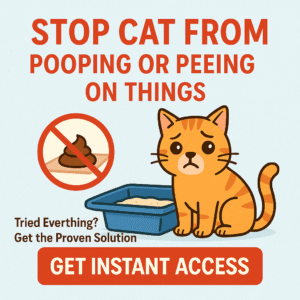Yes, cats do moult—also known as shedding—and it’s a completely normal, natural process. In this detailed guide, you’ll learn why cats shed, when shedding peaks, how to care for their coat year-round, and how to manage excessive shedding. Plus, I’ll show you how the Cat Spray No More ebook—even though it’s focused on spray and marking issues—can help support your cat’s overall wellbeing, including grooming routines.
Quick Answer: Do Cats Moult?
Yes, all cats moult regularly. Shedding removes old or damaged fur to make way for a healthy new coat. It helps regulate temperature, maintain coat structure, and reduce skin irritation.
Why Cats Shed: The Biological Purpose
Shedding serves several important functions:
- Temperature regulation: Cats grow thick undercoats in colder months and shed them when it warms up.
- Coat maintenance: Removing old or damaged hairs keeps the coat smooth and untangled.
- Skin health: Encourages circulation, distributes oils, and minimizes dandruff.
- Self‑grooming assistance: Shed fur is often swallowed and coughed up later as hairballs.
Seasonal Peaks vs. Year‑Round Shedding
Shedding occurs throughout the year, but:
- Spring: Major molt to remove winter undercoat.
- Autumn: Lighter seasonal shed to adjust to cooler weather.
Indoor cats often shed moderately all year due to stable indoor temperatures and lighting, but seasonal patterns remain noticeable.
Breed and Coat Type Matter
| Coat Type | Shedding Characteristics |
|---|---|
| Short‑haired | Moderate, easy to manage with weekly brushing. |
| Medium‑haired | Shedding is noticeable during seasons—2–3 brushes per week recommended. |
| Long‑haired | Heavy shed with risk of mats—daily grooming required. |
| Double‑coated | Significant seasonal shedding; regular deshedding tools help. |
Signs of Healthy vs. Problematic Shedding
- Healthy shedding: Consistent fur loss; soft undercoat visible; no bald patches; cat grooming normally.
- Problematic shedding: Large clumps of fur; bald spots; itching, redness, dandruff; excessive licking or scratching.
If you notice concerning symptoms, consult your vet to check for allergies, parasites, thyroid issues, or skin infections.
Essential Grooming: Reduce Shedding at Home
1. Regular Brushing
Brush short-haired cats weekly; long-haired or double-coated weekly to daily. Use the right tool—slicker brush, deshedding tool (like Furminator), or grooming gloves—to gently remove loose fur and reduce hairballs.
2. Healthy Diet
High‑quality food with omega‑3 and omega‑6 fatty acids improves coat strength and reduces shedding. Ask your vet for recommendations to support skin health.
3. Baths When Needed
Cats rarely need baths, but occasional ones during heavy shedding can help loosen fur. Use a gentle, feline-specific shampoo and towel-dry completely to prevent chills.
4. Hydration and Environment
- Ensure fresh water is always available—hydrated skin is less likely to dry and flake.
- Avoid dry air at home; consider humidifiers during dry seasons.
- Clean living spaces regularly with vacuum, lint rollers, or rubber gloves to manage shed fur.
Managing Shedding in Your Home
- Vacuum floors and furniture weekly (daily during heavy shedding seasons).
- Use washable covers on cat beds and furniture.
- Lint rollers in high-use areas catch stray fur quickly.
- Air purifiers help reduce airborne fur and dander—good for allergy sufferers.
When to Seek Veterinary Help
Consult your vet if you notice:
- Sudden or patchy bald spots
- Inflamed or irritated skin
- Behavioral changes or lethargy
- Excessive scratching, biting, or grooming
- Hairballs accompanied by vomiting or digestion issues
These could point to underlying health problems needing medical attention.
Case Study: Molly, the Long‑Haired Beauty
Molly, a 4‑year‑old Maine Coon mix, was shedding heavily every spring. Her owner combed her once a week, but clumps still fell off. After switching to daily brushing with a deshedding tool, adding omega‑3 supplements (vet‑approved), and introducing an air purifier, fur on the floor and furballs decreased dramatically. Molly’s coat remained glossy, and hairballs became rare.
How the Cat Spray No More eBook Supports Shedding Care
While the ebook is focused on cat spraying and marking, it includes vital grooming, bonding, and environmental strategies that directly impact shedding management. Here’s how it helps:
- Routine Building: Consistent grooming habits are part of daily schedules that reduce stress and support coat health.
- Stress‑Reduction Techniques: Calming pheromones and play routines lower stress—stressed cats shed more.
- Cleaning Protocols: Enzyme-cleaning guidance for accidents crosses over to removing fur-related messes too.
- Holistic Care: The ebook encourages a systemized approach to cat wellbeing—covering grooming, litter care, hydration, and environments.
Step‑by‑Step Shedding Management Plan (14‑Day Guide)
| Days | Focus | Actionable Steps |
|---|---|---|
| 1–2 | Assess & Prepare | Set up grooming tools, choose healthy diet, dry clean living areas. |
| 3–5 | Implement Routine | Brush daily during peak shedding, vacuum regularly, observe coat changes. |
| 6–9 | Enhance Comfort | Add pheromone diffuser, monitor hydration, maintain consistent play and feeding times. |
| 10–14 | Optimize & Adjust | Track results, tweak diet, ensure grooming effectiveness, update cleaning schedule. |
| 15+ | Maintain | Continue routine year-round, review plan seasonally, revisit health check‑ups. |
When Shedding Is Normal & When It’s Not
If the shedding follows predictable patterns—moderate through the year, with spikes in spring and autumn—it’s normal. But if you notice:
- Sudden bald patches
- Inflamed or itchy skin
- Changes in appetite or behavior
These signal that shedding may be symptomatic of more significant problems. In that event, vet consultation is key.
Conclusion: Embrace Healthy Shedding
Yes, cats moult—it’s how they stay clean, comfortable, and healthy. You can support this process through proper grooming, diet, hydration, and environment care. Recognize normal shedding from trouble signs and act proactively.
The Cat Spray No More ebook is more than just a spray‑stopping guide—it’s a complete well‑being manual. It provides structure, calm routines, environmental strategies, and grooming integration—all of which support a clean, fur‑managed, and stress‑free home.
Get your copy of Cat Spray No More now and take control of your cat’s health and your home’s cleanliness. Your cat deserves it—and so do you.
